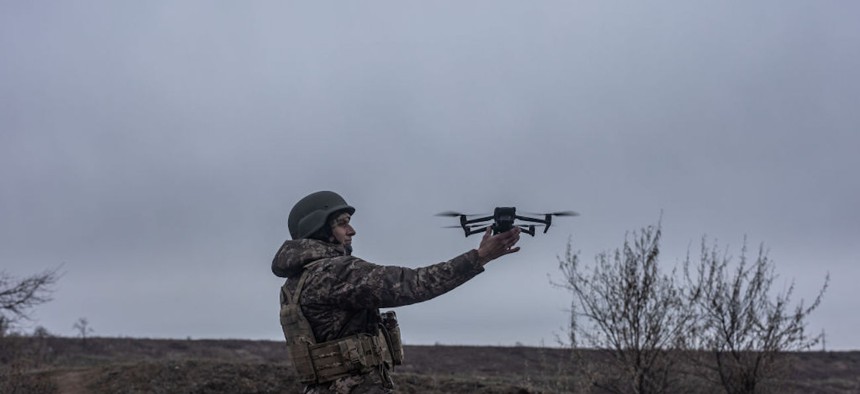Patrick Tucker

Though Congress has been reluctant to provide continued aid for Ukraine, that won’t stop Ukraine from searching for new ways to push back Russian forces, particularly more capable and jam-resistant drones, Ukrainian operators and military officials said Wednesday.
Recent advances in small, commercially-available “first-person-view,” or FPV, drones for warfare have given Ukrainian forces capabilities that don’t exist elsewhere. The country is now working to greatly extend the drones’ reach and effects in the face of sizable Russian electromagnetic warfare capabilities.
Captain Iaroslav Kalinin, a member of the Ukraine Army reserve and CEO of the Ukraine drone startup Infozahyst LLC, explained that modifications to small FPV drones have expanded the potential range between the drone and the operator by 30 kilometers, and increased resilience against advanced EW tactics. He made his remarks during the Association of Old Crows convention in Maryland.
Kalinin’s group is experimenting with non-standard electromagnetic frequency bands and hybrid mesh auxiliary control schemes to avoid Russian detection and jamming.
The drones can be launched from a mother ship to further improve their range when armed with heavy explosives. And with the recent addition of infrared camera sensors, he said, “believe me or not, we're using FPV as interceptors air-to-air” to interdict larger drones moving slower than 90 miles per hour.
But Ukraine faces a similar threat from Russian forces, he said.
“From Ukraine's perspective, what we see right now is we need to produce tens of thousands of electronic countermeasure systems,” and they need solid-state power amplifiers to increase the power of their own jamming systems, he said. “We need to produce this locally as well as yesterday.”.
Though western forces greatly overestimated Russian electromagnetic warfare capabilities at the start of the war, the amount of manpower Russia has dedicated to that effort remains considerable, said Maj. Gen. Borys Kremenetskyi, Ukraine’s defense attache to the United States.
“We estimate the size of Russian electronic warfare troops is around 18 to 20,000 people, equipped with various means,” he said.
Russia is having trouble producing new heavy equipment like tanks and fighters, but its small drone forces are as large as Ukraine’s, and they have a more reliable supply partner in China—as well as Iran.
So as winter sets in, both sides will likely rely more on small drones instead of the larger vehicles that are in short supply.
Ukraine defense innovator Brave1, which was established seven months ago, told Defense One it has awarded some 80 different grants, 20 percent of which were for drones, and approximately 5 percent of which were for electromagnetic warfare. Of the 820 different ideas that innovators have registered on the Brave1 platform, more than 446 have passed military certification, and 390 received medium to high priority for wider development by the Ukraine military.
Russia and Ukraine both will struggle with equipment and weather this winter, but Ukraine is expected to use its home-grown drone capabilities to increase the costs to Russia of occupying Crimea, Ben Hodges, a former commanding general of U.S. Army Europe and a senior advisor to Human Rights First, told Defense One.
Crimea is “he most strategically important part of Ukraine that remains occupied by Russia,” Hodges said.
Ukraine will also seek to reconstitute units worn down by months of conflict, and to improve recruiting, ammo production and operations, he said, as well as train on F-16s.
“The Ukrainians don’t have unlimited resources, of course...especially artillery ammunition and long-range precision weapons. But it’s not too late. Russia lacks a decisive, breakthrough capability to overrun Ukraine, and its logistics system is very fragile, which is a vulnerability Ukraine will exploit. Ukraine will continue to fight for its survival until the West rediscovers its strategic backbone,” he said.
Said Kremenetskyi: “We know we need some other capabilities. But again, despite whether we have them or not, we are not, we are not going to stop and freeze. We are going to fight. ”
No comments:
Post a Comment